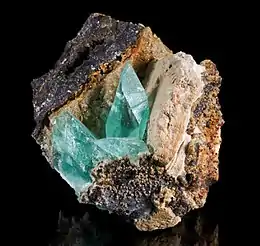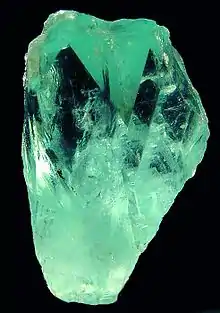Phosphophyllite
Phosphophyllite is a rare mineral composed of hydrated zinc phosphate. Its name derives from its chemical composition (phosphate) and the Greek word for "leaf", phyllon, a reference to its cleavage.[2] It is highly prized by collectors for its rarity and for its delicate bluish green colour. Phosphophyllite is rarely cut because it is fragile and brittle, and large crystals are too valuable to be broken up.[3]
| Phosphophyllite | |
|---|---|
 | |
| General | |
| Category | Phosphate minerals |
| Formula (repeating unit) | hydrated zinc phosphate Zn2Fe(PO4)2•4H2O |
| Strunz classification | 8.CA.40 |
| Crystal system | Monoclinic |
| Crystal class | Prismatic (2/m) (same H-M symbol) |
| Space group | P21/c |
| Identification | |
| Formula mass | 448.40 g/mol |
| Color | Blue-green to colourless |
| Crystal habit | Prismatic |
| Twinning | Common |
| Cleavage | [100] Perfect, [010] Distinct, [102] Distinct |
| Fracture | Conchoidal |
| Mohs scale hardness | 3.5 |
| Luster | Vitreous |
| Streak | White |
| Diaphaneity | Transparent |
| Specific gravity | 3.1 |
| Optical properties | Biaxial (-) |
| Refractive index | nα = 1.595 - 1.599, nβ = 1.614 - 1.617, nγ = 1.616 - 1.620 |
| Birefringence | 0.021 |
| 2V angle | Measured 44°, Calculated 34° |
| Common impurities | Manganese |
| References | [1] |
The finest phosphophyllite crystals come from Potosí, Bolivia, but it is no longer mined there. Other sources include New Hampshire, United States and Hagendorf, Bavaria, Germany. It is often found in association with the minerals chalcopyrite and triphylite.[4]

Twinned Phosphophyllite, Unificada Mine, Cerro de Potosí, Potosí Department, Bolivia. 2.1 x 1.4 x 1 cm.
References
- Mineralienatlas
- "Phosphophyllite". Retrieved 2006-12-16.
- Hall, Cally (1994). Gemstones. Great Britain: Dorling Kindersley. p. 127. ISBN 0-7513-1026-3.
- "The mineral phosphophyllite". Amethyst Galleries, Inc. Archived from the original on 2006-10-17. Retrieved 2006-12-16.
This article is issued from Wikipedia. The text is licensed under Creative Commons - Attribution - Sharealike. Additional terms may apply for the media files.